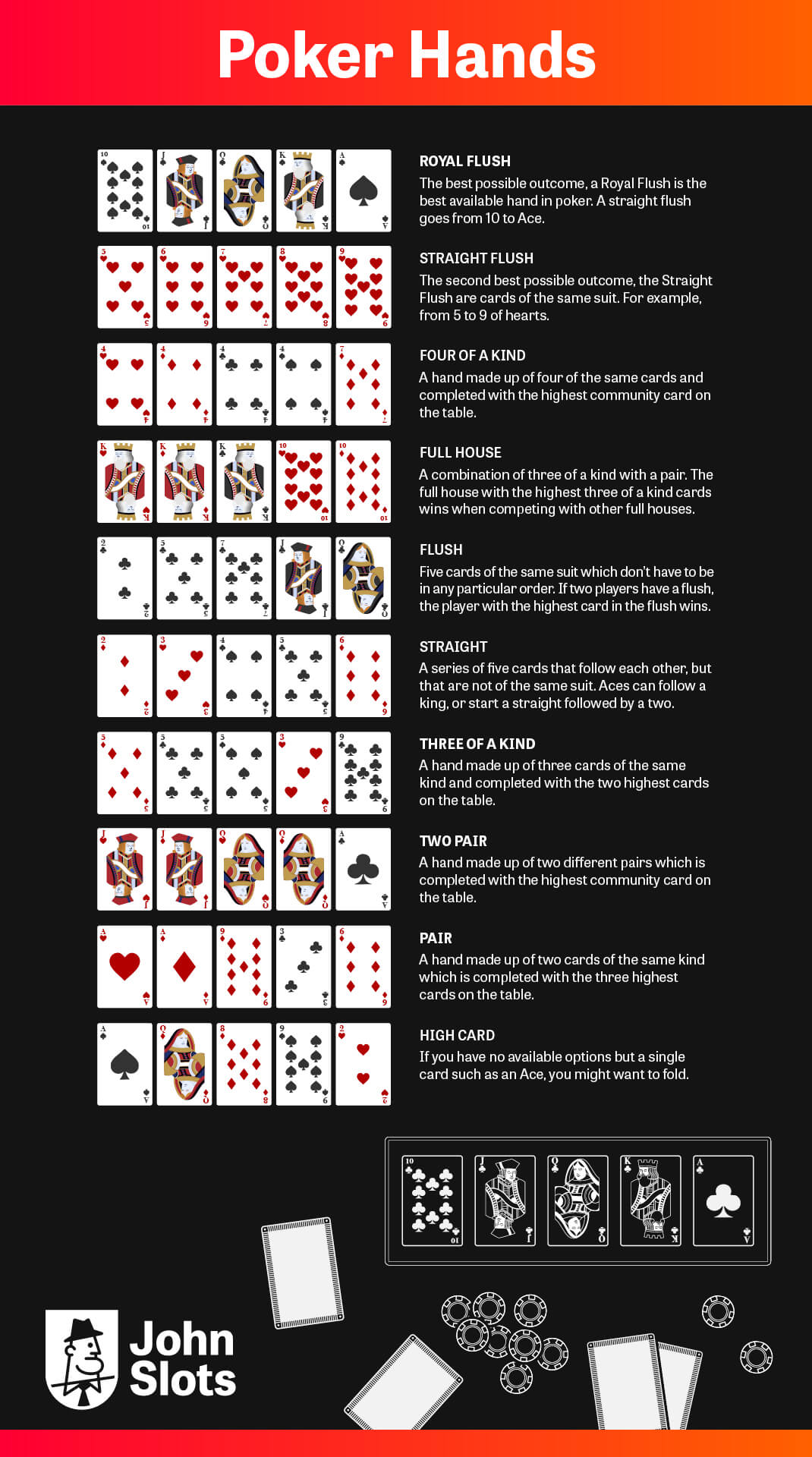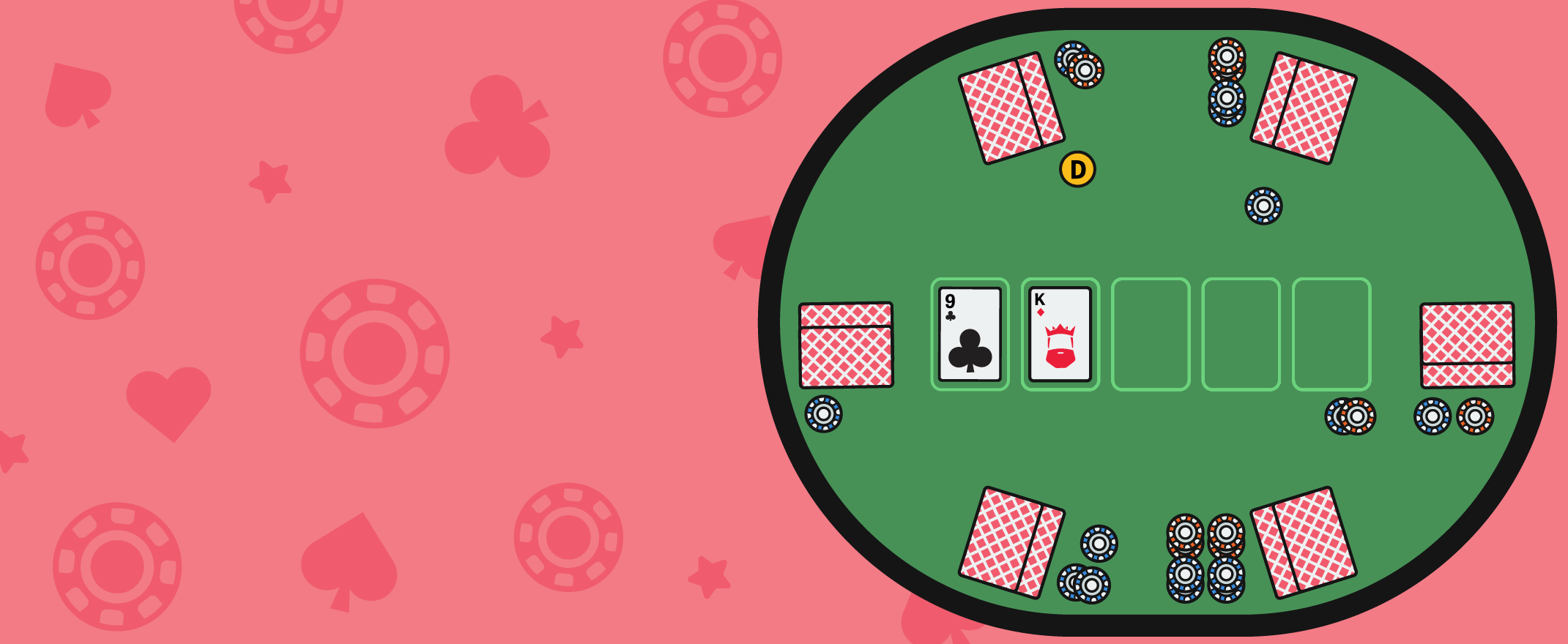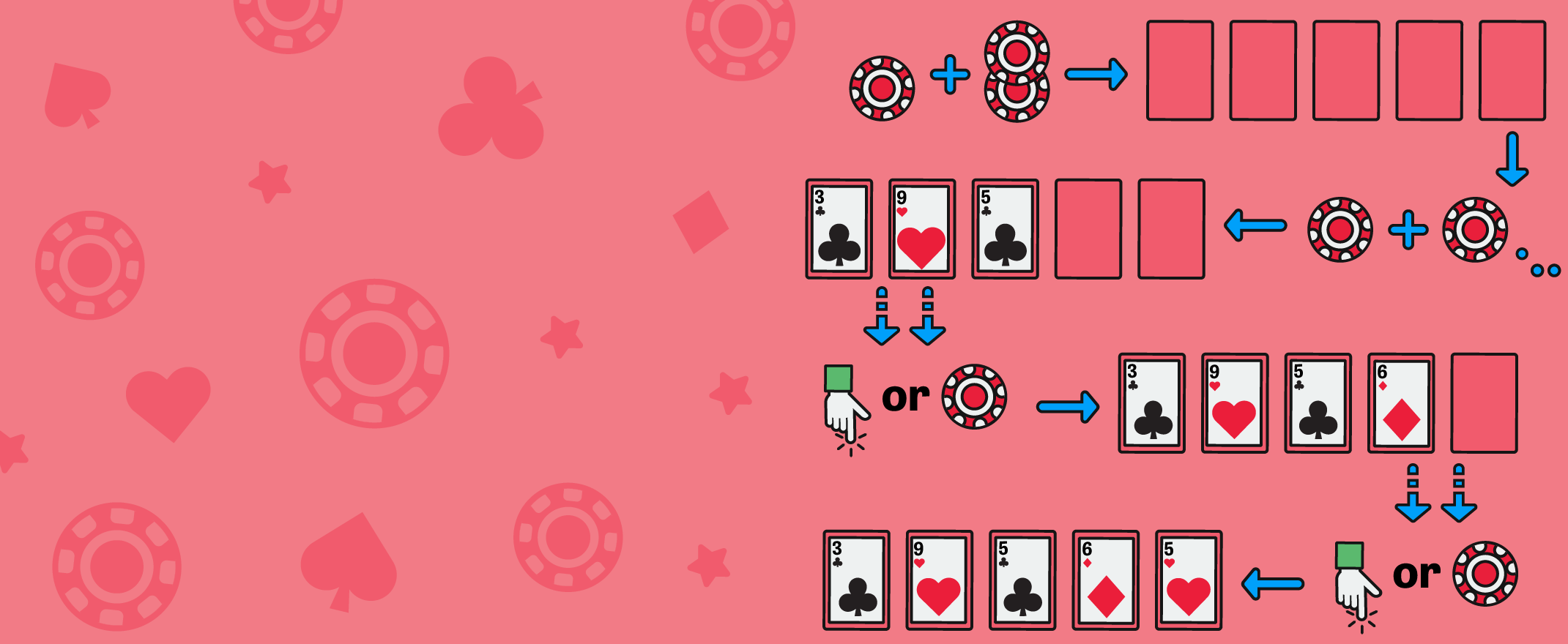Read on to learn about the different terms you are likely to encounter when playing poker, some of the many variations available and information about poker tournaments.
Poker hands
Simply put, a poker hand is a combination of five cards made up of any of the player’s two hole cards and any of the community cards that are dealt to the centre of the table. Hands have different values, so getting a higher value hand than any of your opponents is the ultimate objective of a round of poker.
There are ten named poker hands, which we will introduce below in descending order of value. Cards that are not used in forming a hand, called Kickers, can be used to determine a winner in the case of a tie, when two players have very similar hands.
- 1. Royal Flush – A, K, Q, J and 10 cards, all of the same suit
- 2. Straight Flush – Five cards of the same suit, in sequence
- 3. Four of a Kind – Four cards of the same rank ex. four Jacks or four 10s
- 4. Full House – Three of a kind and a pair ex. Three 10s and two 9s
- 5. Flush – Any five cards of the same suit, out of sequence
- 6. Straight – Five sequential cards of different suits
- 7. Three of a kind – Three cards of the same rank ex. Three 7s
- 8. Two Pair – Two different pairs ex. Two 4s and two 6s
- 9. Pair – Two cards of the same rank ex. Two 10s
- 10. High Card – When none of the other hands are formed, the value of the hand is based on the highest value card. For example, in a hand containing 3, J, 8 4 and 2, the Jack is the high card and determines the value of the hand

The basic poker rules
At its core, poker is about making the right bets (or not betting at all) based on a number of factors – your own cards, the community cards and other players’ betting behaviour.
Sure, professionals make it look easy but inexperienced players may find it difficult to juggle all of these elements when trying to decide what to do next.
Below is a quick round-up of the basic poker game rules, most of which apply no matter what variant of poker you are playing.
The position of players on the table
A player’s seating position at the poker table is an important factor when it comes to determining how to bet. Seating positions depend on which player is acting as the dealer i.e. the one with the button marker in front of them.

The button
In any poker game, there is always a dealer. Now, despite the name, in many cases, the player is not responsible for actually handing out cards – in online poker games, the process is automated and in live games, a professional dealer takes care of this part. However, a player is assigned the title of a dealer and they are recognised by the button.
The button is simply a chip that has the word ‘dealer’ written on it. After a round is played, the button moves to the next player in a clockwise direction.
Early position
Seating positions are based on a player’s location to the button. To the left of the button, we have the small blind and to the left of them is the big blind. These positions, to the immediate left of the dealer, are called early positions. In poker terminology, these are often called Under the Gun positions or UTG.
Early positions are not ideal. These players will have less information about their opponents’ hands because they will have had to act before them. Players located in early positions should be more selective on which starting hands they choose.
Middle position
Next up are the middle positions. These are to the left of the early positions and are considered to be more advantageous over them. In this position, players will be able to gauge their opponents’ behaviour better as more of them will have made their bets.
On the other hand, if a large proportion of early position players fold, middle position players will be in much the same boat as early position ones, so this should be kept in mind when deciding whether to continue with the hand.
Late position
A late position is the best place to be. These are the players who bet after the majority of the table, allowing them to gather the most information about their opponents. Late position players are the ones seated to the right of the dealer, the cut-off, and the dealer him/herself. The cut-off is the second-best position to have, with the dealer being in the best position as they will always bet last.
A table can host between two and ten players in a poker game so these positions are not set in stone but rather are used to describe a player’s position in relation to the dealer and how their location can impact how they bet. A small game might have only one player in each position while larger games can have multiple players sharing a position group.
Because the button moves to the next player after a round is complete, every player will have a chance to be in different positions throughout the game, ensuring that no one is in a disadvantaged position for too long.
Check, bet, fold, call or raise?
These terms are used by players to describe what action they are about to take. Let’s start with the easy one: fold. This means that the player is relinquishing their hand and any bets they have already contributed to the pot, and essentially bowing out of this round of the game.
If the player decides they want to continue participating in the current round, they can do any of the following:
- Bet: This is simply the act of making a bet by putting a number of chips down on the table, contributing to the winning pot.
- Call: The player will match the amount already bet in order to see the next card
- Raise: The bet size is increased, which forces the original bettor to match the new, higher bet if they wish to continue
- Check: This is like saying ‘pass’ – the player is putting off betting, for the time being, allowing another player to bet, at which point the original player can fold, call or raise on the new bet
Poker betting rules
Players make bets at four stages of a poker game, called betting rounds. Each one has a specific name, which helps players keep track of the game’s progress.

1. The blinds
The two players to the left of the button are the blinds, so called because they make their bets without having seen any cards and are therefore ‘betting blind’. These positions are necessary to ensure that there is always something in the pot to be won, otherwise, players could choose to bet only when they have a good hand.
Immediately to the left of the dealer is the small blind and to the left of them is the big blind. The terms refer to player positions as well as the size of the bet they are expected to make – the big blind is usually twice the bet size of the small blind.
2. First betting round – Preflop
This round starts off the game. The small and big blind post their forced bets and each player is dealt their two hole cards, which they keep secret right up until the end of the game. Betting goes in a clockwise manner, with the big blind player closing the action.
3. Second betting round – The Flop
Next comes the Flop. This is when the dealer places the first three community cards face-up in the middle of the table for all to see. Another round of betting follows and astute players will be able to discern how good or bad their opponents’ hands are by watching how they bet.
4. Third betting round – The Turn
In the third round, the dealer places one more community card on the table. Betting once again commences in a clockwise fashion.
5. Final betting round – The River
A final community card is dealt onto the table, bringing the total up to five. The final round of betting takes place.
6. The showdown
This is the point where remaining players reveal their cards to determine who has the highest value hand and therefore wins the pot.
Table stakes and All-in
Table stakes, also known as All-In is a rule that some poker games follow whereby a player cannot bet more money than they had on the table when the hand started. This puts a limit on how much a player can lose while also keeping the amount other players are forced to bet in check.
A player can re-buy chips or add-on in between hands, just not during a hand, as long as that amount does not exceed the max buy-in.
Betting limits
Poker games have rules about how much money can be wagered. These poker betting rules help to pace the game a certain way and helps players choose which games they would prefer to play, depending on their preferred betting style.
No limit
This is the most straightforward betting limit because there isn’t one! Players can bet as much as they like, provided that they have the chips to do it. Got 100 chips in front of you? In a No Limit game, you can bet them all if you choose.
Pot Limit
In a Pot Limit game, a player can bet between a specified a minimum amount, which is valid and unchanged throughout play, and the current size of the pot.
Fixed Limit
Fixed limit games have a set minimum and maximum bet, usually the small and big blind amount, respectively. Players may only bet one of these two amounts in any round.
Different types of poker games
The ingenuity of gamblers knows no bounds, as shown by the range of poker variations that exist. In coming years, we will no doubt see even more variants being developed.
There are three types of poker game into which all variations are categorised. These are as follows:
- Draw poker: In these games, players are dealt a complete hand, which is kept hidden. They can then improve the hand by replacing cards
- Stud poker: Each player receives a combination of face-down and face-up cards over a number of betting rounds.
- Community card poker: Each player is dealt an incomplete, hidden hand and combinations are made using the shared or community cards
Texas Hold’ em rules
This is a type of community card poker and probably the most commonly played version. Players aim to create the highest value combination of cards using their two hole cards and any of the community cards, with four rounds of betting as more community cards are dealt.
Omaha poker rules
Closely related to Texas Hold’em, Omaha rules poker is a community game where four cards are dealt to each player, who must then use exactly two of their cards and three community cards to create the best hand possible.
Omaha Hi-Lo poker rules
Also called Omaha hi-low split-8 or better (or simply Omaha/8, which is less of a mouthful), each player aims to create two hands, each made of five cards. One hand will be high value, made of 8 or higher cards, and the other will be lower, Ace to 8. The pot is split between the high winner and the low winner, which can potentially be the same player.
The player is dealt 4 hole cards and can use any two to create their high and low hands. If no one has a qualifying low hand, the high hand winner takes the whole pot.
7-Card Stud poker rules
This variation is one of the most common, particularly in casual home games. 7 card stud rules are fairly similar to Hold’em, with some important distinctions.
Instead of two hole cards, players are dealt three cards each, two hidden and one face-up. The player with the lowest exposed card starts the action. Players are dealt seven cards in total and there are five betting rounds. The best five-card hand wins.
Seven Card Stud Hi/Lo poker rules
In this version, two hands win the game – the high hand and the low one. Like the Omaha version, the 8 card falls into both the high and the low groups and can be used in both hands. Aces are always low and a player can win both halves of the pot with a straight or a flush.
Razz poker rules
This stud poker variant is one of the oldest, having been emerged back when people started using a 52-card deck instead of a 20-card deck in games of poker.
Razz is a form of lowball poker, where the objective is to create the five-card combination with the lowest value from the seven cards dealt. Aces are always low and flushes and straights do not count against for low.
Draw poker rules
Draw poker refers to any variant where the player is dealt a complete hand and then aims to improve it over a series of rounds by replacing or ‘drawing’ new cards.
Chinese poker rules
This game is played between two to four players and uses 13 cards. The objective is to create three hands of increasing value. Two hands are made of five cards and the remaining hand of three cards.
This beginner-friendly game involves a high degree of luck, which means that novices have a good chance of beating even highly experienced players.
2-7 Triple Draw poker rules
This is a lowball type of poker, often called Kansas City lowball or simple low poker. This is basically the opposite of standard poker in that high hands lose. The 2-7 method is not as commonly used as the A-5 method.
Five-card draw poker rules
Players are dealt two cards at the start, one hidden and one face-up, and a betting round follows. Another three cards are dealt face-up, each followed by a betting round.
The objective is to create the best five-card hand but the fact that players can see one of everyone’s cards changes the game significantly from standard poker.
Caribbean Stud poker rules
Caribbean Stud is played against the house rather than other players and it is derived from five-card stud poker. The player starts by making an ante wager and player and dealer are dealt 5 cards each. Only one dealer card is exposed.
The player can then fold or raise and the dealer then turns over their remaining four cards. To qualify, the dealer must have an Ace plus a King or higher. If the dealer qualifies, the player loses. If the dealer does not qualify, the player wins and claims the ante and the raise.
Casino Hold’em poker rules
Also called Caribbean Hold’em, this game was developed in 2000. It is based on Texas Hold’em rules but the opponent is the house instead of other players.
Once the dealer qualifies, it is a straight contest between the player and the dealer’s hands.
Pai Gow Poker rules
This game is played on a 52-card deck plus one joker card. The objective is to defeat the banker, which can be the dealer or another player at the table.
To win, a player must create two hands out of the seven cards they are dealt – one five-card, the other two-card – that beats both of the dealer’s own hands.
Video poker rules
Video poker is essentially a digitised version of a real-life poker game. A number of variations are available, including Deuces Wild, Jokers Wild, Tens or Better and even progressive jackpot poker games.
Different poker tournaments
For players who want to enjoy a more competitive poker structure, tournaments are the way to go. These pit players against one another over several games and can be very exciting and challenging.
There are different sorts of tournament structures and our article about poker tournaments has more detailed information.
Sit and Go rules
These tournaments are fast-paced and perfectly suited to inexperienced players who want a low-pressure opportunity to play competitively.
A number of seats are available, across several tables, and once all of them are occupied, the tournament can begin.
Freeroll rules
Freeroll tournaments are attractive to players because they have no buy-in fee. Players simply bet during the game without having to pay an initial amount to join.
Summary
The world of poker is constantly evolving and it might seem like an impenetrable cloud of terminology, rules, and actions. However, with the basics covered, most players find that they can turn their hand to any poker variation with a little practice and determination and win in any online casino games.

Frequently asked questions about poker rules
Read what others have been often wondering about poker rules.
What is the best poker hand?
This depends on which variation you are playing. For standard poker, the best hand is the Royal Flush. However, in lowball poker, it is the lowest value hand that wins.
Who wins if two people each have a straight?
In this case, the Kickers will come into play to determine which hand wins. These cards are the ones that do not contribute to the hand but can act as a tiebreaker depending on which one has the higher value.
How do I know the betting limits?
Every poker game has a betting structure and will display this prominently to make it easy for potential players to see.
Where can I see the rules of each poker variant?
As you can see, there are heaps of different types of poker. There are many online resources to help guide you, including several here at JohnSlots.
How do I know the tournament rules?
Tournaments can have a range of structures. For more tips and info, head to our article on poker tournaments.
What is a royal flush in poker?
A royal flush is the highest value hand you can make. It is made up of the A, K, Q, J and 10 cards in the same suit.
Does a straight beat a flush?
No, a flush beats a straight in poker. If you’ve got a straight flush will beat it every time.
What happens when you go all-in in poker?
All-in refers to the betting structure of a game. In such games, players can bet as many chips as they have available.
Do you have to show your hand in poker?
In standard poker, the two cards dealt with the player are kept a secret from others until the very last part of the game, called the Showdown.
What happens if you can’t match a bet in poker?
In a table stakes games, a player can go all-in to avoid being forced out because they do not have enough chips to bet.
Does a straight have to be the same suit?
No. Your sequence can be composed of cards belonging to any combination of suits, as long as they are in order.
What is 4 of a kind?
This hand is made up of four cards of the same rank but in any combination of suits. For example, four 6s or four Ks.
What is 3 of a kind?
Having three cards of the same rank, like three Jacks, for instance, counts as a Three of a Kind hand.
What are the odds of four of a kind?
The odds of landing one of the 156 possible combinations of four of a kind are 4,165 to 1.
Do suits matter in poker?
Poker suits matter in that some hands require cards to be of the same suit. However, suits are all equal value so having a seven of clubs and a seven of diamonds, for example, are considered the same value.
How many poker combinations are there?
There are a whopping 2,598,960 possible combinations in poker!
How rare is it to get a royal flush?
The odds of landing a royal flush are 649,740 to 1, or 0.000154% probability. This is so rare because there are only four hands that qualify, one for each suit.
Can anything beat a royal flush?
No. It is the highest value hand you can have in standard poker.
What happens if everyone checks in poker?
If everyone checks during a round, the round is considered complete and the next round can commence.
What is a freeroll in poker?
If a tournament is a freeroll, players do not have to pay a buy-in fee to participate.
Casino Game Specialist
6+ Years of Experience

Statistics
34 Articles
Harper Gallagher is a respected specialist in online casino games, particularly craps, poker and casino table games. By staying abreast of emerging technologies and trends, she inspires others to pursue their own passions in the exciting world of online casino gaming.
Expert On:


